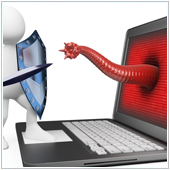When looking to purchase new technology for a business, many business owners or managers will take their time to shop around and look for the best option available. Nowadays, most of this research is done over the Internet. As you probably know, everyone has an opinion on the Internet, and this can make it harder to figure out which tech is actually good, and what isn’t. This is especially true for Microsoft’s new tablet, the Surface Pro.
Here’s a brief overview of the four main pros and cons of the Microsoft Surface Pro.
Pros
1. Windows 8
The Surface Pro comes with Windows 8 Pro installed. This is the full version – all the functionality of the desktop is on the tablet. For businesses this means that almost any program you use on your Windows 8 desktop will also be useable on the Surface Pro; you can truly take the office with you.
If you don’t use Windows 8 at the office, but use an older version of Windows, most programs will still work because Windows 8 supports many legacy Windows programs (Windows 7, Vista and some XP programs).
2. You can connect almost anything
Unlike similar tablet devices, the Surface Pro comes with a full USB port which can accommodate almost any USB device, including external hard drives. There is also a mini DisplayPort which, with an adapter, you will be able to connect an external monitor or projector to.
Beyond that, the Surface Pro also has a MiniSD card slot which allows for up to 64GB of extra storage space. There is also an attachable keyboard case which connects to the tablet by magnets, and gives users a full laptop style keyboard and mouse trackpad.
3. The screen is gorgeous
The 10.6 inch screen of the Surface Pro has a resolution of 1920X1080 pixels, which means the display is full HD. When comparing it to the screen of the iPad 4, most users will not notice much of a difference. For the visual experts among you, the resolution translates to a 16:9 ratio, which means the device is widescreen, much like modern laptop monitors.
4. It’s powerful
The Surface Pro has a third generation Intel i5 processor and 4GB of RAM. This is similar to many mid-range laptops currently on the market and is miles ahead of any other business tablet currently available. What this means for most business users is that they will be able to run almost all of their business programs without a problem.
Cons
1. Battery life
Most 10-inch tablets will have between 6 and 10 hours of battery life under normal use conditions – some Web browsing, email, Wi-Fi on, movie playing and screen on a normal level of brightness. The Surface Pro will get around four hours, or less if you are working with programs that require more computing resources.
The reason for the lower than average battery life is largely due to the bigger, faster processor and the HD screen. On the other hand, the battery life is good when compared to similar laptops.
2. Mobility is limited
This device is meant to be held in landscape method (think of an open book). This is evident with the kickstand on the back of the device and the fact that the attachable keyboard cover is only useable in landscape mode.
What’s more, the device is quite heavy for a tablet, many users won’t be able to hold it for long periods. User reviews have also shown that with the keyboard cover attached, the device won’t sit on a lap, only on a flat surface.
In other words, if you plan to move around a lot, or work with the tablet on your lap, you’re going to have a tough time of it. It will be even harder if you have peripherals attached.
3. Storage space is limited
Looking at the Surface Pro website, you can see that it comes with two hard drive options – 64GB and 128GB. It’s important to note that these numbers are the size of the hard drive before Windows 8 is installed. After the OS is installed, users will have a paltry 23GB and 83GB respectively. Want to install Microsoft Office 2013? Take off another 8GB.
On the plus side, there is a MicroSD slot which can support a card with up to 64GB of space, and the USB port allows you to connect an external hard drive, but that is hardly ideal especially if you are looking for a mobile solution.
4. The price
The Surface Pro is by no means cheap. The 64GB version costs USD$899 while the 128GB version costs USD$999. Want the keyboard cover? The soft version (Surface Touch Cover) costs an extra USD$119 while the hard version (Surface Type Cover) costs USD$129. Add in the cost of an extra hard drive, and this device could cost over USD$1,000. A laptop from a reputable manufacturer with similar hardware could cost as low as USD$500.
Should I buy it for my business?
While the price alone will put many prospective business owners off purchasing this device as a tablet, it is a viable solution that could, in theory, replace a laptop. If you are interested in purchasing a Surface Pro, or would like to know more about how it could fit into your business, please contact us today.
4 Pros And Cons Of The Surface Pro

As a business owner or manager you likely have many different things on your mind at any given time. One issue that many owners fret over is whether their networks, computers and the data stored within are secure enough. The vast majority of businesses do utilize anti-virus scanners, however, there is still a chance their systems may be attacked. Finding out how may help find a solution.
There are several ways in which malware can be introduced to your systems, even those protected by anti-virus scanners or other security measures. Here are three you might need to know about::
- Attacking remote users
Traditionally, business was carried out in a physical office. This means that companies only had to protect internal networks and systems. However, businesses are increasingly going mobile and relying on off-site workers. Problems can arise though when steps are not taken to ensure the security of these endpoints – laptops, tablets, mobile devices, etc.
Attackers know this, and have started to attack remote workers who may not be as secure as the company’s internal systems. This becomes an even bigger issue when the infected device is brought back to the office and connected to the network – thus likely introducing the malware into your systems. It’s necessary to ensure that all remote employees and devices are secure in order to protect your core systems and that they are also following the same security protocols used on-site and in-house..
- USB infections
The majority of malware is introduced to systems via the Internet and websites. This is the reason why almost all virus-scanners focus on web-based intrusions. To a large extent, these scanners do what they are supposed to and keep companies secure. Hackers are always looking for new ways to attack systems though, and one avenue is through USB drives.
Some of the more popular USB-based malware takes advantage of Auto-Run – when an external hard drive, or USB flash drive is plugged in, this feature automatically opens the drive. The malware on the drive is configured to install itself when the drive boots up and is accessed, thus infecting systems.
To limit the chances of being infected by malware you should either provide drives for your employees to use, or approve drives that come in from outside sources. If you use USB drives to transfer files or share files between computers, try looking into other options like cloud storage drives. Finally, disabling Auto-Run and scanning drives with a virus-scanner, (many programs can actually do this), could go a long way toward deterring infections.
- Anti-virus misses malware
While many companies have anti-virus scanners and software to deter malware infections, in order for these programs to work they often require daily or weekly updates. These updates contain information about new forms of malware discovered, along with detection and handling rules.
However, many companies may not be allowing the virus scanners to update. Because of this, systems are at an increased risk of being infected by newer malware. Therefore, ensure that your anti-virus scanners are not only up-to-date but are set to scan on regular intervals.
Beyond this, it is important to know that while anti-virus scanners will go a long way in preventing infections, they are often a step behind the newest malware. Taking steps to prevent malware, such as limiting downloads, educating employees and establishing a security policy can also help.
Finally, if you are worried about the security of your systems, working with an IT partner can prove to be one of the most successful ways of minimizing security threats that could harm your organization. IT partners can implement a plan to lower infection rates and employ experts who are able to work with you to restore your systems quickly should they become affected.
If you are looking to make your business more secure, get in touch with us today.
Published with permission from TechAdvisory.org. Source.
Leave A Comment!
Published on 11th April 2013 by Jeanne DeWitt.


